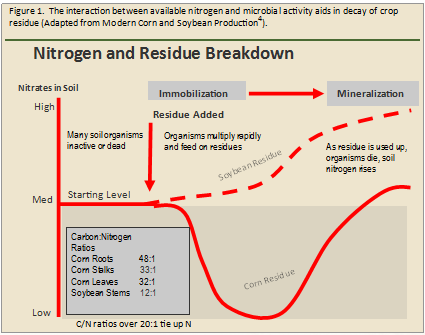- Crop residue decomposition is largely driven by biological processes.
- Carbon (C) to nitrogen (N) ratio differs among crops and affects immobilization and mineralization processes.
- Soil microbes help crop residue decomposition/breakdown.
The soil biological community needs C and N for food and energy. Crop residue provides organic C and N to soil biology, and physically protects soil from wind and water erosion. Agricultural practices affect residue amount, distribution, and size. Residue decomposition however, is controlled by biological processes and influenced by environmental and soil conditions.1
Nitrogen Cycle and Carbon to Nitrogen Ratio
Within the N cycle, the residue decomposition process relies on immobilization and mineralization, both of which involve soil microbes (Figure 1). Immobilization is when N is consumed by soil microbes. Mineralization is the release of N that generally happens upon the death of soil microbes. Nitrogen within residue is tied up (immobilized) until decomposition is complete and is released by soil microbes through mineralization.

Carbon to nitrogen (C:N) ratios vary greatly among crop residues. Alfalfa, soybean, and other legumes generally have lower C:N ratios near 20:1, which usually results in quicker mineralization.2 Corn has a higher C:N ratio (70:1), takes more time to decay, and could result in higher N amounts required by the microbes to decompose residue.2 Soil microbes try to maintain a C:N ratio of approximately 10:1.3 If not taken into account, the microbe requirement for N can compete with a growing corn crop.
Decomposition
Nearly 50 pounds of residue are produced for each bushel of corn harvested.5 Crop residue is composed of lignin, cellulose, hemicellulose, and nutrients.
Microorganisms breakdown these components, and decomposition rate depends on moisture and temperature. Some conditions that advance decomposition of residue include warm, moist weather, smaller residue pieces, and maximizing contact between residue and the soil.
Nitrogen deficiency symptoms can develop during immobilization; however, research has not consistently shown a benefit to fall N applications intended to assist in residue decomposition.6 The effectiveness of fall N applications is related to timing, cooler temperatures, and/or dry weather. Higher rates of spring-applied N may be applied since the typical N rate may be immobilized by microbes for residue decomposition during the growing season.
Disturbing soils with tillage may not increase residue decomposition. A recent three-year study evaluated the effect of tillage on residue decomposition. Laboratory and field results demonstrated no significant differences in the decomposition or percent residue that remained among strip-tillage, deep tillage, and no-till systems.1


Management
Residue can be managed by increasing the populations of soil microorganisms. A major portion of soil microbes live in a state of dormancy as they are under starvation conditions, especially in tilled soils.3 Cover crops provide additional energy, carbon, and N to sustain activity of a wide range of soil microorganisms.
According to a three-year study in Iowa soils, corn residue was reduced to below 45 percent after 12 months in the field.1 Crop rotation cycles that include legume crops with lower C:N ratios allows N to be mineralized into soil more quickly and gives residue with higher C:N ratios (such as corn and small grains) more time to decompose.
Summary
Soil microorganisms use nutrients from crop residue and will immobilize N before mineralizing the nutrient. Crop C:N ratio is an indication of how quickly residue can be decomposed and N released. Fall N applications and tillage are not sustainable economically or environmentally. Both practices bring additional management costs and can negatively affect water quality. Tillage could further deteriorate soil health and may increase the risk of soil erosion on some soils. Residue breakdown is facilitated by practices that enhance soil health and soil microorganism populations.
Sources:
1 Al-Kaisi, M. 2014. Myths and facts about residue breakdown. Iowa State University. Integrated Crop Management News. http://www.extension.iastate.edu.
2 Mannering, J. and D. Griffith. Value of crop rotation under various tillage systems. Purdue University Extension. AY-230.
3 Hoorman, J.J. and R. Islam. 2010. Understanding soil microbes and nutrient recycling. The Ohio State University. SAG-16-10.
4 Hoeft, R.G. et. al. 2000. Modern corn and soybean production. MCSP Publications. Champaign, Illinois. Pages 121-131.
5 Lardy, G. 2011. Utilizing corn residue in beef cattle diets. North Dakota State University. AS1548.
6 Al-Kaisi, M. 2007. Tillage challenges in managing continuous corn. Iowa State University. IC-498(1).
